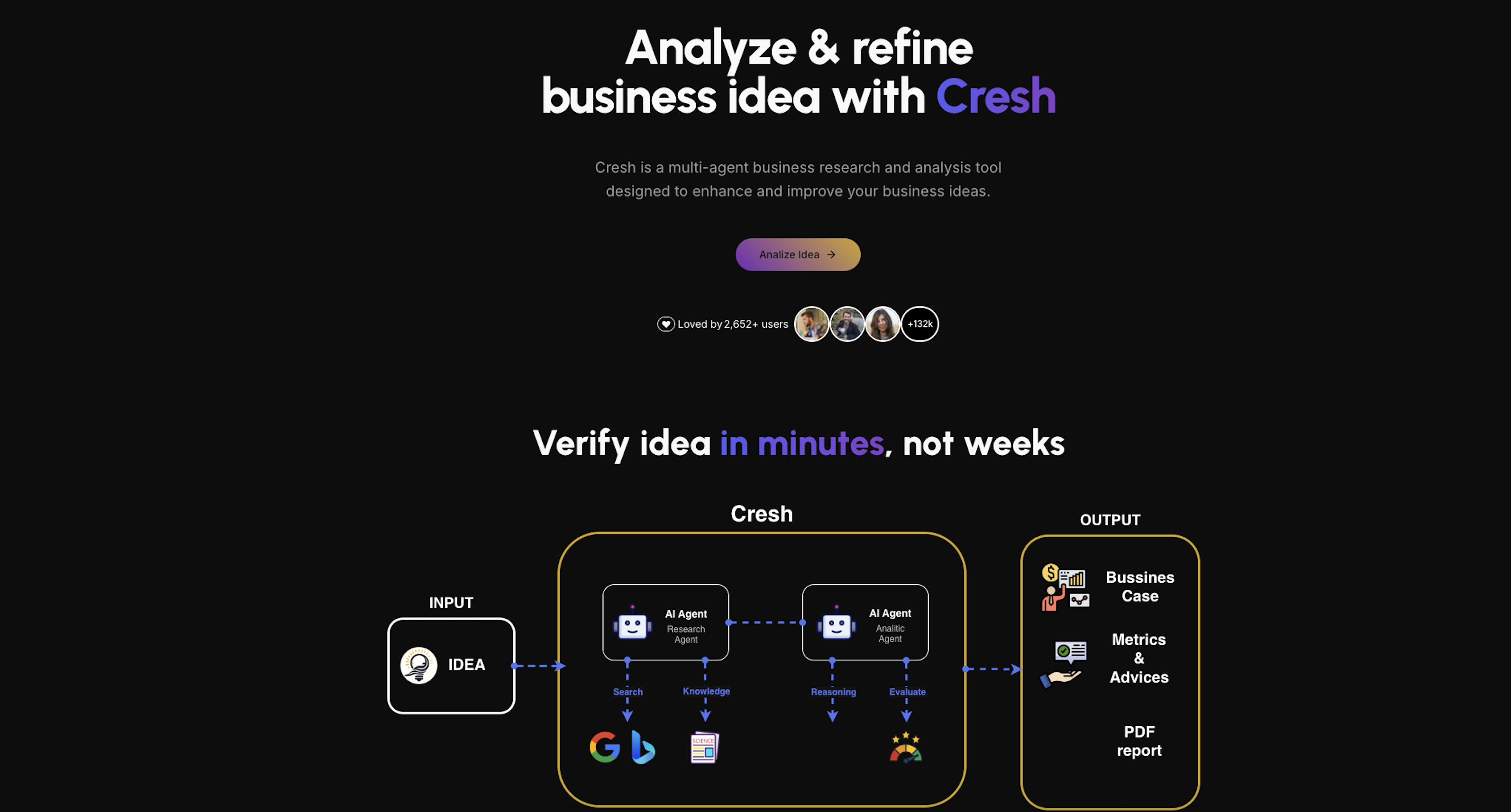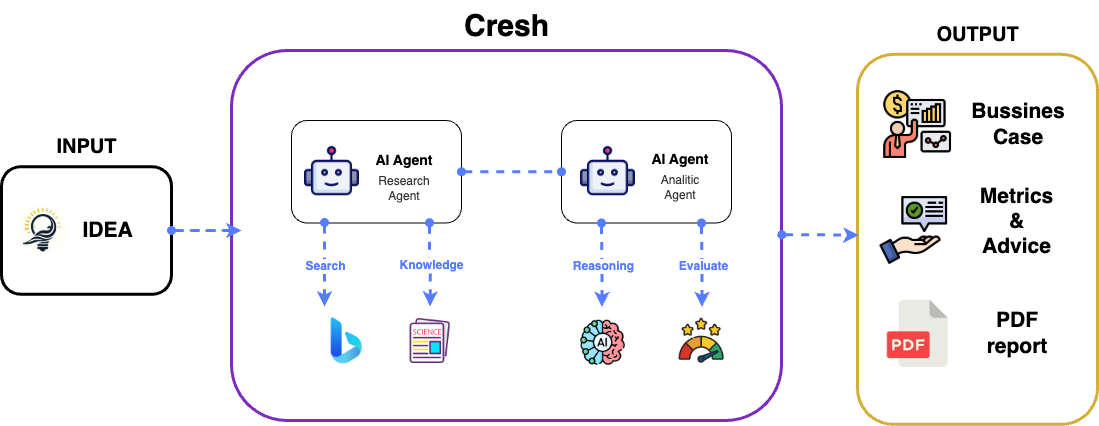Accelerating Innovation: AI’s Framework Turning Weeks into Minutes
Understand how does the Cresh work!
Arti

Human history tells the story of our species' journey through slow evolutionary processes, adaptation to a changing world and discoveries that changed our lives. Humans have continually shaped their environment, and thanks to our ability to cooperate, innovate and solve problems, we have been able as a species to experience events that have changed our fate forever. The major ones, which we refer to as revolutions, are characterized by rapid and fundamental changes leading to a radical shift in society, technological capabilities and ways of thinking, replacing old structures with new ones. The agrarian, industrial or digital revolution accelerated the development not only of entire civilizations, but had a real impact on the daily life of the individual.
We can learn about most of these transformations from textbooks, but it is becoming more and more obvious that another one is happening right before our eyes. The development of AI technology is gaining momentum on a path leading to a complete revolutionization of our lives in a very broad spectrum of aspects. The opportunities provided by the development of AI are outdating existing approaches replacing them with new, more effective ones.
In the age of global information flow, which is often critical, AI can become an invaluable tool for us. Complicated and time-consuming analysis methods such as SWOT or PEST become possible to generate in seconds.
Observing these changes and trends, we also saw our mission in them. We set ourselves the goal of developing a new, more accurate and holistic framework for evaluating ideas, making the most of the capabilities of today's artificial intelligence. Doing this without developed language models was cumbersome due to the enormous amount of work required to do so. Today, thanks to the use of modern models, the extensive knowledge contained in databases and publications, and the enormous potential offered by the Internet, we are able to map our idea into a condensed form turning weeks of research into mere minutes.
Cresh Framework
In creating our framework we gave ourselves assumptions:
- holistic, meaning that it analyzes the idea in terms of market, product and risks,
- comparable, two analyses can be compared to each other,
- intuitive, allowing you to draw preliminary conclusions instantly,
- universal, fits for any idea, for creators, investors or enthusiasts.
Operating principle
Facing complex assumptions, from the beginning we wanted the framework to be implemented by AI models supported by modern knowledge bases and the Internet. The input to the system to be a description of the idea, and the output to be the most accurate analysis done in minutes together with sources, which saves weeks of research.
The working model can be found below.

Format of the framework
The basis of our framework is separate metrics that describe each espect of the idea. Each metric takes a value from 1 to 5, where 1 is a potential threat/weakness, while 5 is an opportunity/strength. For each indicator, the scale has a different meaning and definition, allowing for personalization of the metrics and their refinement.
The metrics are divided into 5 groups to test specific aspects of an idea:
- Market Viability - need, market and trends
- Market Strategy - ecosystem (competition, legislation, distribution), market acquisition and costs
- Product Viability - parameters of the potential product
- Risk & Finance - implementation risks and finances
- Technical Viability - research and technological aspects
Market Viability
The first group we present is Market Viability, which examines the need, the size of the potential market and studies trends. The group allows you to quickly see if there is a need for a particular innovation. The group consists of the 5 metrics shown below.
| Number | Metric | Main question |
|---|---|---|
| 1 | Need | Does the innovation solve a problem, fill a need or satisfy a customer desire? |
| 2 | Potential market | How large and sustainable is the total market for all products fulfilling this function? |
| 3 | Trend of demand | Is demand for such an innovation expected to increase, remain constant or decrease over the life of the idea? |
| 4 | Duration of demand | Is demand for the innovation expected to be “long-term”? |
| 5 | Demand predictability | How accurately will sales be predictable? |
Market Strategy
Another category examines the ecosystem in which the idea is located. An important aspect is competition and potential future competition and safeguarding against it. Here we also examine issues related to marketing research and its costs. To round out the ecosystem issue we added the topic of legitimacy and distribution. Nowadays, distribution is usually done through one of the available channel, and access to it makes up the overall market picture.
| Number | Metric | Main question |
|---|---|---|
| 1 | Existing competition | Does the innovation already face competition that will make it difficult and costly to enter the market? |
| 2 | New competition | Is the innovation likely to encounter new competition from other innovations that may threaten its market share? |
| 3 | Marketing research | How much effort will be required to define a product and price that the end market will find acceptable? |
| 4 | Promotion cost | Is the cost and effort of promotion to achieve market acceptance of the innovation in line with the expected returns? |
| 5 | Distribution | How difficult will it be to develop or gain access to distribution channels for the innovation? |
| 6 | Legality | Does the new product idea meet the requirements of applicable laws, regulations and product standards and avoid exposure to product liability? |
Product Viability
We have finally arrived at the topic of the product. Of course, it's impossible to evaluate a product before it's created, so our framework doesn't focus on aspects like design, but on aspects of how it fits with current standards, customers and trends. We have set 8 metrics that will allow you to look at your potential product from multiple categories. The caveat here, however, is that the categories should be taken individually and a low score in one of them does not necessarily indicate a problem. It only informs you of potential aspects to look after.
| Number | Metric | Main question |
|---|---|---|
| 1 | Product line potential | Can the innovation lead to other profitable products or services? |
| 2 | Societal benefits | Will the innovation benefit society in general? |
| 3 | Compatibility | Is the innovation compatible with current attitudes and ways of doing things? |
| 4 | Learning | How easy is it for a customer to learn how to use the innovation properly? |
| 5 | Visibility | How obvious are the advantages of the innovation to the potential customer? |
| 6 | Function | Does the innovation work better than alternatives or perform a function that is not currently available? |
| 7 | Durability | Will this innovation survive “long use”? |
| 8 | Price | Does this innovation have a price advantage over competitors? |
Risk & Finance
We decided to combine two aspects into one group. On the one hand, we lean into the aspects of risk and its mitigation, by analyzing threats at launch, dependencies and potential safeguards by, for example, patents. On the other hand, we are trying to determine the financial side of the venture, by searching through reports and analogies. We lean into the potential size of the investment, production costs, sales volume, profits and payback time.
| Number | Metric | Main question |
|---|---|---|
| 1 | Development risk | What degree of uncertainty is associated with full commercialization from the current state of the innovation to market readiness? |
| 2 | Dependence | To what extent does this innovation lose control of its market and sales due to dependence on other products, processes, systems or services? |
| 3 | Protection | Is it likely that cost-effective commercial protection can be obtained for this innovation through patents, trade secrets or other means? |
| 4 | Size of investment | How much investment is needed to implement the product? |
| 5 | Potential sales | Can the sales volume of this particular innovation be sufficient to justify starting the project? |
| 6 | Payback period | Will the initial investment pay off in the early stage of the innovation? |
| 7 | Profitability | Will the expected revenues from the innovation provide higher returns than other investment opportunities? |
| 8 | Cost of production | Does production at a reasonable cost level seem possible? |
Technical Viability
The last aspect we are looking at is the technical aspect. A large part of today's StartUps are based on modern high-tech, so we couldn't leave out this aspect. We start our analysis with the overall feasibility of creating an innovation, through the advantages of using the technology and the required research effort for it. We end with the technology needed to produce the solution and its cost.
| Number | Metric | Main question |
|---|---|---|
| 1 | Technical feasibility | Is the technical solution robust and complete? |
| 2 | Functional performance | Does the innovation perform better than alternatives? |
| 3 | Research and development | How much research and development goes into bringing a solution to market? |
| 4 | Technology significance | How much can the use of the given technology revolutionize an industry? |
| 5 | Technology of production | Are the technology and skills required to produce the new product idea available? |
| 6 | Tooling cost | How heavy a burden is the cost of the production tooling required to meet expected demand? |
Performance result
As outlined above, the framework generates 33 metrics, which are rated on a scale of 1 to 5. The metrics are divided into 5 categories for easier analysis. The quality of the analysis is ensured by linguistic models supported by knowledge from search engines, knowledge bases and scientific publications.
With these tools, each metric is accompanied by:
- an explanation of a given score
- a suggestion for potential improvement
- the sources on which the answer was created.
An example of the analysis can be found here: Cresh - AI Business Idea Analysis
Benefits
- Saving time associated with monotonous research. Ratio of weeks of manual work to several minutes of AI work.
- Deeply analysis, which touches every aspect of the project.
- Ease of reading the analysis through the use of groups.
- Addition of explanations and suggestions through the use of AI reasoning models.
- The ability to explore new niches in minutes.
Summary
The framework is currently in the testing phase but is already saving us many weeks. I encourage you to share your feedback to help us improve it.
If you want to see how to use the framework for quick analysis I refer you to my previous article: How to validate your business idea in minutes
On the other hand, if you want to try the framework yourself in action I invite you to our website: Cresh - AI Business Idea Analysis
